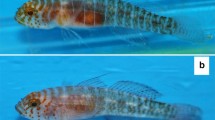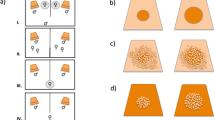Abstract
The reproductive behavior of female whitebelly damselfish, Amblyglyphidodon leucogaster, was investigated in the Gulf of Aqaba, Red Sea over two breeding seasons. Females were promiscuous, mating with 7–10 different males throughout the season. Females lay eggs in distinct batches, defined as the total number of eggs laid in a day. Generally females deposit a batch of eggs with one male (87.2%) and are capable of laying a new batch every other day. Egg batch size averaged 4009 eggs and females laid from 2 to 22 egg batches per season. The variation in spawning success was not correlated to body size. Females preferred to deposit eggs in nests that already contained early stage eggs (0–2 days old). Within a nest, females chose to lay eggs contiguous to the youngest egg batch, regardless if the nest contained either a single batch or multiple batches of different ages. Female within-nest spawning patterns appear to be a consequence of between nest preferences for nests with young eggs. It is proposed that the strong within-nest preference is a consequence of mate selection where females may use new egg batches as a visual cue as part of a copying style. Such a style may reduce the risk of predation and increase feeding opportunities, because less time is expended in mate selection, which would provide additional resources for egg production and ultimately increase female spawning success over the breeding season.
Similar content being viewed by others
References cited
Allen, G.R. 1991. Damselfishes of the world. Mergus Publishers, Melle. 271 pp.
Blumer, L.S. 1982. A bibliography and categorization of bony fishes exhibiting parental care. Zool. J. Linn. Soc. 76: 1–22.
Cole, K.S. & Y. Sadovy. 1995. Evaluating the use of spawning success to estimate reproductive success in a Caribbean reef fish. J. Fish Biol. 47: 181–191.
Côte, I.M. & W. Hunte. 1989. Male and female mate choice in the redlip blenny: why bigger is better. Anim. Behav. 38: 78–88.
Dugatkin, L.A. 1992. Sexual selection and imitation: females copy the mate choice of others. Amer. Nat. 139: 1384–1389.
Fishelson, L., D. Popper & A. Avidor. 1974. Biosociology and ecology of pomacentrid fishes around the Sinai Peninsula (northern Red Sea). J. Fish Biol. 6: 119–133.
Goldschmidt, T., T.C.M. Bakker & E. Feuth-De Bruijn. 1993. Selective copying in mate choice of female sticklebacks. Anim. Behav. 45: 541–547.
Goulet, D. 1992. Reproductive biology and mating success of males and females in a Red Sea damselfish (Amblyglyphidodon leucogaster). Ph.D. Thesis, University of Puerto Rico, Mayaguez. 122 pp.
Goulet, D. 1995. Temporal patterns of reproduction in the Red Sea damselfish Amblyglyphidodon leucogaster. Bull. Mar. Sci. 57: 582–595.
Gronell, A.M. 1989. visiting behaviour by females of the sexually dichromatic damselfish, Chrysiptera cyanea (Teleostei: Pomacentridae): a probable method of assessing male quality. Ethology 81: 89–122.
Gross, M.R. & R.C. Sargent. 1985. The evolution of male and female parental care in fishes. Amer. Nat. 25: 807–822.
Hastings, P.A. 1988. Female choice and male reproductive success in the angel blenny, Coralliozetus angelica (Teleostei: Chaenopsidae). Anim. Behav. 36: 115–124.
Hoelzer, G. 1988. Filial cannibalism in a non-brood cycling marine fish. Env. Biol. Fish. 21: 309–313.
Hoelzer, G.A. 1990. Male-male competition and female choice in the Cortez damselfish, Stegastes rectifraenum. Anim. Behav. 40: 339–349.
Hoelzer, G.A. 1992. The ecology and evolution of partial-clutch cannibalism by paternal Cortez damselfish. Oikos 65: 113–120.
Horne, E.A. & M. Itzkowitz. 1995. Behavior of the female beaugregory damselfish (Stegastes leucostictus). J. Fish Biol. 46: 457–461.
Karino, K. 1995. Male-male competition and female choice through courtship display in a territorial damselfish, Stegastes nigricans. Ethology 100: 126–138.
Karino, K. & A. Nakazono. 1993. Reproductive behavior of the territorial herbivore Stegastes nigricans (Pisces: Pomacentridae) in relation to colony formation. J. Ethol. 11: 99–110.
Knapp, R.A. & R.R. Warner. 1991. Courtship as an honest indicator of male parental quality in the bicolor damselfish, Stegastes partitus. Behav. Ecol. 2:295–300.
Knapp, R.A., P.C. Sikkel & V.T. Vredenburg. 1995. Age of clutches in nests and the within-nest spawning-site preferences of three damselfish species (Pomacentridae). Copeia 1995: 78–88.
Kraak, S.B.M. 1996, ‘Copying female mate choice’: which phenomena deserve this term? Behav. Process. 36: 99–102.
Kraak, S.B.M. & T.G.G. Groothuis. 1994. Female preference for nests with eggs is based on the presence of the eggs themselves. Behaviour 131: 189–206.
Lindström, K. 1992. Female spawning patterns and male mating success in the sand goby Pomatoschistus minutus. Mar. Biol. 113: 475–480.
Marconato, A. & A. Bisazza. 1986. Males whose nests contain eggs are preferred by female Cottus gobio L. (Pisces, Cottidae). Anim. Behav. 34: 1580–1582.
Petersen, C.W. & K. Marchetti. 1989. Filial cannibalism in the Cortez damselfish Stegastes rectifraenum. Evolution 43: 158–168.
Pomiankowski, A.N. 1987. The costs of choice in sexual selection. J. Theor. Biol. 128: 195–218.
Ridley, M. & C. Rechten. 1981. Female sticklebacks prefer to spawn with males whose nests contain eggs. Behaviour 76: 152–161.
Rohwer, S. 1978. Parent cannibalism of offspring and egg raiding as a courtship strategy. Amer. Nat. 112: 429–440.
Rowland, W.J. 1982. Mate choice by male sticklebacks, Gasterosteus aculeatus. Anim. Behav. 30: 1093–1098.
Sargent, R.C. 1982. Territory quality, male quality, courtship intrusions, and female nest-choice in the threespine stickleback, Gasterosteus aculeatus. Anim. Behav. 30: 364–374.
Sargent, R.C. 1988. Paternal care and egg survival both increase with clutch size in the fathead minnow, Pimephales promelas. Behav. Ecol. Sociobiol. 23: 33–37.
Sargent, R.C., M.R. Gross & E.P. Van den Berghe. 1986. Male mate choice in fishes. Anim. Behav. 34: 545–550.
Sikkel, P.C. 1989. Egg presence and developmental stage influence spawning-site choice by female garibaldi. Anim. Behav. 38: 447–456.
Sikkel, P.C. 1994a. Why female garibaldi prefer males with young eggs: a test of the parental investment hypothesis. Ethol. Ecol. Evol. 6: 191–211.
Sikkel, P.C. 1994b. Filial cannibalism in a paternal-caring marine fish: the influence of egg developmental stage and position in the nest. Anim. Behav. 47: 1149–1158.
Thresher, R.E. 1984. Reproduction in reef fishes. T.F.H. Publications, Neptune City, 399 pp.
Trivers, R.L. 1972. Parental investment and sexual selection. pp. 136–179. In: B. Campbell (ed.) Sexual Selection and the Descent of Man, Aldine, Chicago.
Unger, L.M. & R.C. Sargent. 1988. Allopaternal care in the fathead minnow, Pimephales promelas: females prefer males with eggs. Behav. Ecol. Sociobiol. 23: 27–32.
Wade, M.J. & S.G. Pruett-Jones. 1990. Female copying increases the variance in male mating success. Proc. Nat. Acad. Sci. USA 87: 5749–5753.
Williams, G.C. 1975. Sex and evolution. Princeton University Press, Princeton. 200 pp.
Author information
Authors and Affiliations
Rights and permissions
About this article
Cite this article
Goulet, D. Reproductive behavior and spawning success of female Amblyglyphidodon leucogaster (Pisces: Pomacentridae) from the Red Sea. Environmental Biology of Fishes 50, 49–60 (1997). https://doi.org/10.1023/A:1007350601234
Issue Date:
DOI: https://doi.org/10.1023/A:1007350601234




